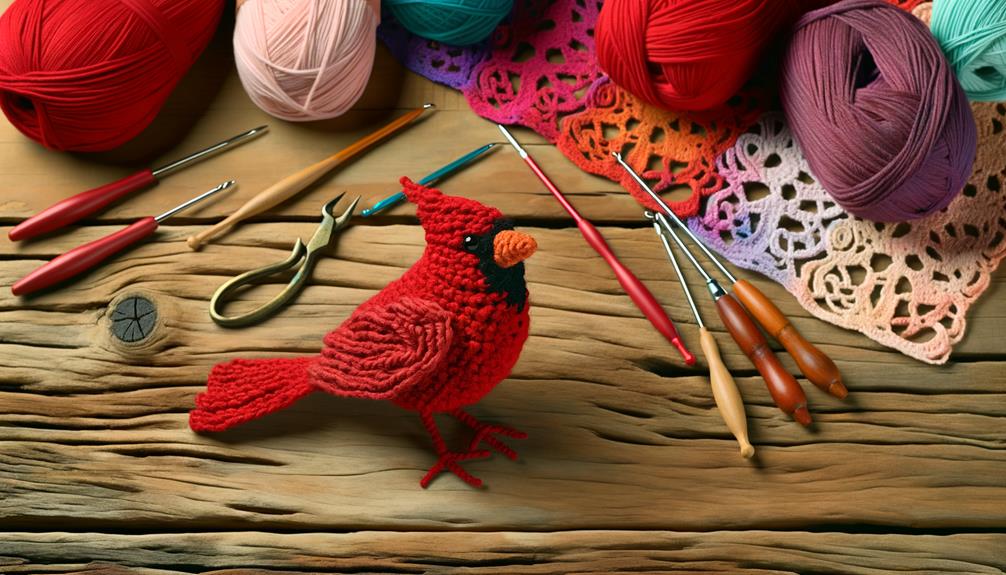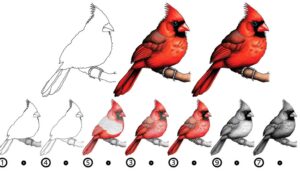10 Steps to Crochet a Cardinal Bird: Beginners Guide
To crochet a cardinal bird, start by gathering materials: a 3.5mm hook, tapestry needle, stitch markers, craft scissors, and polyester fiberfill. Opt for medium-weight acrylic yarn in vivid red, black, and white.
Begin with the body using single crochets, incorporating increases and decreases for shaping. Craft wings with gradual expansions and a textured tail using fpdc and bpdc stitches.
Create a beak with yellow yarn and attach beads for eyes. Assemble the parts with whip stitches, ensuring symmetry.
Stuff the bird firmly but evenly to maintain shape. This guide provides a structure for crafting a beautiful crochet cardinal bird.

Key Takeaways
- Choose medium-weight red, black, and white yarn with a 3.5mm-4mm crochet hook.
- Crochet the bird's body using single crochet stitches, incorporating increases and decreases for shaping.
- Create the wings and tail separately with chain and double crochet stitches, ensuring symmetry.
- Attach the beak and eyes securely, using yellow or orange yarn for the beak and black beads or embroidery floss for the eyes.
- Assemble all parts with a whip stitch, stuff gradually with polyester fiberfill, and trim any excess yarn.
Materials Needed
To begin your crochet project of creating a cardinal bird, you will need to gather the following materials.
First, make sure you have a set of crochet hooks; commonly, a 3.5mm (E-4) hook is ideal for detailed work.
You will also need a tapestry needle for sewing parts together.
Stitch markers are essential for keeping track of your rounds.
A pair of craft scissors will help you cut yarn cleanly.
Additionally, procure polyester fiberfill for stuffing the bird, giving it a plush, three-dimensional form.
Safety eyes, typically 6mm, will bring life to your cardinal.
Finally, don't forget a row counter to monitor your progress and keep your stitch count accurate.
With these materials, you're well-equipped to begin.
Choosing the Right Yarn
Choosing the right yarn is essential for achieving the desired texture and appearance of your crocheted cardinal bird. Opt for a high-quality, medium-weight yarn to guarantee durability and a smooth finish. Acrylic yarn is a popular choice due to its versatility and ease of care, while wool offers a warm, natural feel. Consider the following yarn characteristics to guide your selection:
| Yarn Characteristic | Preferred Option |
|---|---|
| Fiber Type | Acrylic or Wool |
| Weight | Medium (Worsted, #4) |
| Texture | Smooth or Slightly Fuzzy |
| Color | Vivid Red, Black, White |
| Yardage | 100-150 yards |
Selecting yarn with these properties will enhance the intricate details of your cardinal bird, ensuring a stunning final product.
Selecting Your Hook
Selecting the appropriate crochet hook is crucial for achieving the precise stitch definition and overall structure of your cardinal bird. Typically, a 3.5 mm (E-4) to 4 mm (G-6) hook works well with the recommended yarn weight for this project.
The hook size influences the tightness of your stitches; a smaller hook will create tighter stitches, which is ideal for amigurumi and guarantees your cardinal bird retains its shape. When choosing your hook, consider the comfort of the handle, especially if you plan to crochet for extended periods. Ergonomic hooks can reduce hand strain.
Test different hooks with your chosen yarn to confirm a smooth glide and consistent tension. Achieving the right balance will enhance the detail and longevity of your creation.
Basic Stitches Overview
Mastering the basic stitches is essential to successfully crafting your crochet cardinal bird, as each stitch contributes to the intricate patterns and textures of the project. Start with the necessary chain stitch (ch), which forms the foundation.
Next, practice the single crochet (sc), creating a tight, dense fabric ideal for shaping the bird's body. The double crochet (dc) stitch adds height and texture, useful for details like wings and tail feathers.
Slip stitches (sl st) are pivotal for joining parts seamlessly. Finally, increase (inc) and decrease (dec) techniques will help shape your cardinal, giving it a realistic form.
Familiarize yourself with these stitches, and you'll be well-equipped to bring your charming crochet cardinal bird to life.
Creating the Body
To begin creating the body of your cardinal bird, select a vibrant red yarn to capture the bird's striking plumage, along with a small amount of black for the facial accents.
Start with a magic ring and crochet in continuous rounds, using increases and decreases to shape the body to a natural, rounded form.
Follow the pattern closely to guarantee the proportions are accurate, allowing the bird's unique silhouette to emerge.
Choosing Yarn Colors
When creating the body of your crochet cardinal, opt for a rich, vibrant red yarn to capture the bird's iconic and striking plumage. Selecting the right yarn is vital for achieving a realistic and eye-catching result.
Here are some considerations to keep in mind:
- Fiber Type: Choose a soft, durable yarn like acrylic or cotton for easy handling and a smooth finish.
- Yarn Weight: Opt for a medium (worsted) weight yarn to make sure the cardinal maintains its shape and structure.
- Color Consistency: Make sure the red yarn is uniform in color to avoid patchy spots on your project.
- Texture: A smooth, non-fuzzy yarn will provide clean stitches and help highlight the intricate details of the bird's body.
These choices will greatly impact the overall quality and appearance of your crochet cardinal.
Shaping the Body
With your chosen red yarn in hand, start shaping the body of the cardinal by creating a magic ring and crocheting a specified number of single crochets into it to form the base. Typically, six single crochets (sc) are recommended. Pull the ring tight and join with a slip stitch (sl st).
Continue by increasing stitches in each round: 2 sc in each stitch around for the second round (12 sts), then 1 sc in the next stitch, 2 sc in the following stitch (18 sts). Keep increasing until the body reaches the desired width.
Once the base is set, crochet in continuous rounds without increasing to create the height of the bird's body, ensuring a smooth, seamless form.
Crocheting the Wings
To begin crocheting the wings of your cardinal bird, start by selecting a vibrant red yarn that matches the body for a cohesive appearance.
Next, follow detailed wing patterns to shape the wings, ensuring they are symmetrical and proportionate to the body.
Selecting Yarn Colors
For crocheting the wings of your cardinal bird, choose a rich, vibrant red yarn to capture the bird's distinctive and striking coloration. The yarn selection is essential to achieving the lifelike appearance of the cardinal's wings. Opt for a medium-weight yarn that provides both durability and ease of use. Consider the following factors when selecting your yarn:
- Color Consistency: Ensure the red hue matches the cardinal's natural shade.
- Texture: A smooth, soft texture will make the wings look more realistic.
- Durability: Pick a yarn that can withstand handling and display.
- Fiber Content: Acrylic or a wool blend offer the best balance of color retention and stitch definition.
Selecting the right yarn will enhance the overall aesthetic of your crocheted cardinal.
Shaping Wing Patterns
Begin by creating a foundation chain of 10 stitches to start shaping the primary structure of the cardinal's wings.
Once the chain is complete, work a single crochet (sc) in the second chain from the hook. Continue with single crochets across the remaining chains to establish the base row.
For the next row, chain one and turn your work. Perform single crochets across, increasing at the end by working two single crochets into the last stitch. This will help achieve a slight wing curvature.
Repeat this pattern for four more rows, ensuring to increase at the beginning and end of each row.
This gradual expansion creates the distinctive, graceful shape of the cardinal's wings, ready for further detailing.
Attaching Wings Securely
With the wing patterns shaped and ready, carefully align them against the cardinal's body, ensuring symmetrical placement before stitching them securely in place. Use a yarn needle and matching yarn to whipstitch the wings to the sides of the bird, maintaining even tension to avoid puckering.
Pay close attention to the following steps to achieve a professional finish:
- Position Wings: Place wings at the same height on both sides.
- Stitch Evenly: Use small, consistent stitches for a neat attachment.
- Secure Knots: Tie off securely to prevent unraveling.
- Hide Ends: Weave in loose ends to maintain a clean look.
Crafting the Tail
To craft the tail of your crochet cardinal, consistently work in rows of double crochet stitches while gradually decreasing to shape the tapering end. Begin by chaining 12 stitches, then double crochet across.
On each subsequent row, decrease one stitch at the beginning and end by working two double crochets together (dc2tog). This technique will create a gradual taper. Continue decreasing until only one stitch remains. Fasten off and weave in the ends to secure.
For added texture, consider incorporating front post double crochet (fpdc) and back post double crochet (bpdc) stitches sporadically throughout the rows. This creates an authentic feathered appearance, enhancing the overall aesthetic of your crochet cardinal.
This detailed approach guarantees a beautifully crafted tail.
Making the Beak
For a lifelike and organized beak, start by chaining 6 stitches using a vivid yellow or orange yarn.
Next, single crochet (sc) in the second chain from the hook and in each chain across. Turn and single crochet back across, reducing by one stitch at the beginning and end of each row until you have one stitch remaining.
Fasten off, leaving a tail for sewing.
- Materials Needed: Yellow or orange yarn, scissors, needle.
- Stitch Guide: Chain (ch), single crochet (sc), decrease (dec).
- Shape Creation: Ensure balance by decreasing evenly.
- Finishing Touch: Use the yarn tail to sew the beak firmly onto the bird's head.
This technique guarantees your cardinal's beak is both proportionate and durable.
Adding the Eyes
Carefully position small black beads or embroidery floss to craft the cardinal's eyes, making sure they are symmetrically aligned just above the beak.
For bead eyes, use a tapestry needle to sew the beads onto the head, securing tightly to avoid shifting. If opting for embroidery floss, thread a needle with black floss and use French knots to form the eyes. Create each knot by wrapping the floss around the needle twice before inserting it back into the same stitch.
Ensure the knots are of even size and placed precisely. Check alignment by viewing the bird head-on, adjusting as necessary to achieve a balanced appearance.
Properly positioned eyes contribute significantly to the cardinal's lifelike charm and overall aesthetic.
Assembling the Parts
To begin assembling your cardinal bird, start by attaching the wings to the sides of the body using a whip stitch, ensuring symmetry on both sides.
Next, secure the tail to the back of the body, aligning it properly to create a natural flow.
Attaching Body Pieces
Begin by aligning the edges of the crocheted body pieces, guaranteeing that the stitches match up perfectly for a uniform and seamless assembly. Using a tapestry needle and coordinating yarn, whip stitch the pieces together, taking care to maintain tension for a tidy finish.
- Pin pieces together first: This guarantees accurate alignment.
- Use a whip stitch: Ideal for creating a clean, invisible seam.
- Stuff as you go: Add stuffing gradually to avoid lumps.
- Secure knots: Firmly secure all knots to prevent unraveling.
Pay close attention to the shape and structure as you go, making adjustments as needed to preserve the cardinal's natural form. Once the main body is assembled, double-check all seams and stuffing for consistency and smoothness.
Adding Final Touches
With the body pieces firmly stitched and stuffed, position the wings symmetrically on each side of the cardinal, making certain they mirror each other perfectly. Use pins to hold them in place before stitching. Next, attach the feet to the bottom of the body, ensuring stability. Sew the beak onto the face, centering it between the eyes. Finally, add any decorative elements such as a crest or tail feathers to enhance realism.
| Part | Position |
|---|---|
| Wings | On each side of the body |
| Feet | Bottom of the body |
| Beak | Centered between the eyes |
| Eyes | Evenly spaced on the face |
| Crest/Tail | Top of head/End of body |
Take care with stitching to make sure all parts are securely fastened.
Final Touches
Adding the final touches to your crochet cardinal bird involves carefully stitching on the beak and eyes to bring your creation to life. Begin by attaching the beak using orange yarn. Secure it firmly with a yarn needle, ensuring it's centered.
Next, sew on the eyes using black embroidery thread, positioning them symmetrically on either side of the beak. For added detail, you can embroider white highlights on the eyes to give a more realistic appearance.
- Beak: Use orange yarn, sew securely.
- Eyes: Attach with black thread, symmetrical placement.
- Highlights: Embroider small white stitches on eyes.
Finally, for a polished finish, conduct a final inspection to check for any loose ends and trim any excess yarn.
Your crochet cardinal is now complete and ready to be displayed!
Conclusion
To sum up, mastering the craft of crocheting a cardinal bird requires meticulous attention to detail and a thorough understanding of crochet techniques.
One example is Jane, a novice crocheter who followed a structured guide to create a lifelike cardinal as a gift for her grandmother.
Her dedication to choosing the right materials and perfecting each stitch resulted in a beautiful, handcrafted piece that brought joy to her family.
This showcases the rewarding nature of this intricate art form.






